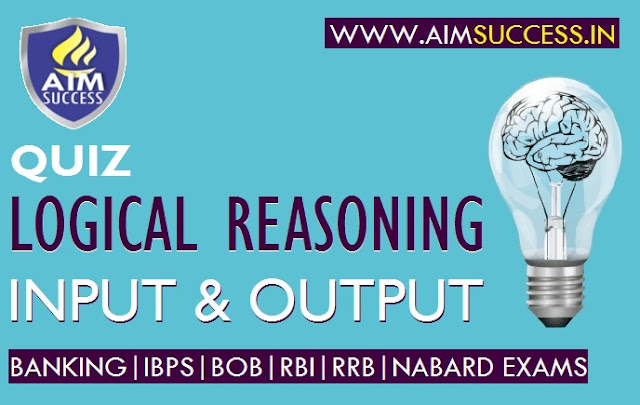INPUT OUTPUT for SBI PO/Clerk Mains 2018: 10 July
Directions (Q. 1-4): Study the following information carefully and answer the given questions:
A word and number arrangement machine when given an input line of words and numbers rearranges them following a particular rule in each step. The following is an illustration of input and rearrangement. (All the numbers are two-digit numbers.)
Input:tall 48 13 rise alt 99 76 32 wise jar high 28 56 barn
Step I:13 tall 48 rise 99 76 32 wise jar high 28 56 barn alt
Step II:28 13 tall 48 rise 99 76 32 wise jar high 56 alt barn
Step III:32 28 13 tall 48 rise 99 76 wise jar 56 alt barn high
Step IV:48 32 28 13 tall rise 99 76 wise 56 alt barn high jar
Step V:56 48 32 28 13 tall 99 76 wise alt barn high jar rise
Step VI :76 56 48 32 28 13 99 wise alt barn high jar rise tall
Step VII: 99 76 56 48 32 28 13 alt barn high jar rise tall wise
And Step VII is the last step of the above input, as the desired arrangement is obtained.
As per the rules followed in the above steps, find out in each of the following questions the appropriate step for the given input.
Input:84 why sit 14 32 not best ink feet 51 27 vain 68 92 (All the numbers are two-digit numbers.)
1. Which step number is the following output?
32 27 14 84 why sit not 51 vain 92 68 feet best ink
1) Step V
2) Step VI
3) Step IV
4) Step III
5) There is no such step.
2. Which word/number would be at 5th position from the right in Step V?
1) 14
2) 92
3) feet
4) best
5) why
3. How many elements (words or numbers) are there between ‘feet’ and ‘32’ as they appear in the last step of the output?
1) One
2) Three
3) Four
4) Five
5) Seven
4. Which of the following represents the position of ‘why’ in the fourth step?
1) Eighth from the left
2) Fifth from the right
3) Sixth from the left
4) Fifth from the left
5) Seventh from the left
Directions (Q. 5-9): Study the following information carefully and answer the given questions:
A word and number arrangement machine when given an input line of words and numbers rearranges them following a particular rule in each step. The following is an illustration of input and rearrangement. (All the numbers are two-digit numbers.)
Input: set near 14 19 went 20 78 ago 80 toy 36 pink 42 colour
Step I: went set near 19 20 78 ago 80 toy 36 pink 42 colour 14
Step II: went toy set near 20 78 ago 80 36 pink 42 colour 14 19
Step III: went toy set pink near 78 ago 80 36 42 colour 14 19 20
Step IV: went toy set pink near colour 78 ago 80 42 14 19 20 36
Step V: went toy set pink near colour ago 78 80 14 19 20 36 42
Step VI: went toy set pink near colour ago 80 14 19 20 36 42 78
Step VII: went toy set pink near colour ago 14 19 20 36 42 78 80
Step VII is the last step of the above input, as the desired arrangement is obtained.
As per the rule followed in the above steps, find out in each of the following questions the appropriate step for the given input.
Input: one 15 and 90 two 88 12 make 18 so 21 thus 56 near. (All the numbers are two-digit numbers.)
5.Which step number is the following output?
two thus so one near and 90 88 make 56 12 15 18 21
two thus so one near and 90 88 make 56 12 15 18 21
1) Step V
2) Step VI
3) Step IV
4) Step III
5) There is no such step
6.How many elements (words or numbers) are there between ‘make’ and ‘18’ as they appear in last but one step?
1) 3
2) 4
3) 5
4) 2
5) 6
7.How many steps would be required to get the final output?
1) Five
2) Six
3) Four
4) Seven
5) None of these
8.Which of the following represents the position of ‘and’ in the fifth step?
1) Sixth from the left
2) Seventh from the left
3) Fourth from the right
4) Eighth from the left
5) Sixth from the right
9.Which word/number would be at fifth position from the right in Step VI?
1) 12
2) 18
3) 90
4) and
5) 15
Answers:
(1-4):
The machine rearranges words and numbers in such a way that numbers are arranged from left side with the smallest number coming first and move subsequently so that in the last step numbers are arranged in descending order. While the words are arranged from right side as they appear in English alphabetical order.
Input: 84 why sit 14 32 not best ink feet 51 27 vain 68 92
Step I: 14 84 why sit 32 not ink feet 51 27 vain 68 92 best
Step II: 27 14 84 why sit 32 not ink 51 vain 68 92 best feet.
Step III: 32 27 14 84 why sit not 51 vain 68 92 best feet ink
Step IV: 51 32 27 14 84 why sit vain 68 92 best feet ink not
Step V: 68 51 32 27 14 84 why vain 92 best feet ink not sit
Step VI: 84 51 32 27 14 why 92 best feet ink not sit vain
Step VII: 92 84 51 32 27 14 best feet ink not sit vain why
- 1. 5
- 2. 4
- 3. 2; 27, 14 and best
- 4. 3; Step IV: 51 32 27 14 84 why sit vain 68 92 best feet ink not The position of ‘why’ in this step is sixth from the left end.
(5-9):
The machine rearranges words and numbers in such a way that numbers are arranged from right side and words are arranged from left side. While numbers are arranged in ascending order, words are arranged in reverse alphabetical order.
Input: one 15 and 90 two 88 12 make 18 so 21 thus 56 nears.
Step I: two one 15 and 90 88 make 18 so 21 thus 56 near 12
Step II: two thus one and 90 88 make 18 so 21 56 near 12 15
Step III: two thus so one and 90 88 make 21 56 near 12 15 18
Step IV: two thus so one near and 90 88 make 56 12 15 18 21
Step V: two thus so one near make and 90 88 12 15 18 21 56
Step VI: two thus so one near make and 90 12 15 18 21 56 88
Step VII: two thus so one near make and 12 15 18 21 56 88 90
- 5. 3
- 6. 2; Sixth step is the last but one. There are four elements between ‘make’ and ‘18’. The element are : and, 90, 12 and 15
- 7. 4
- 8. 2; Step V: two thus so one near make and 90 88 12 15 18 21 56 Thus,Seventh from the left is ‘and’.
- 9. 5; Step VI: two thus so one near make and 90 12 15 18 21 56 88. Thus fifth from the right is 15











